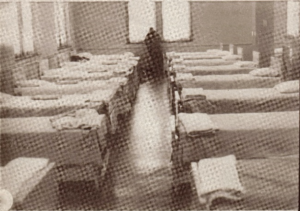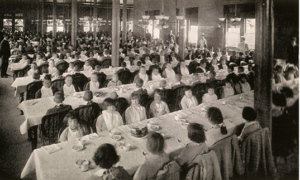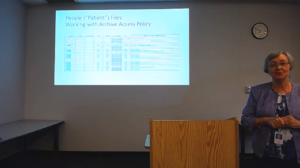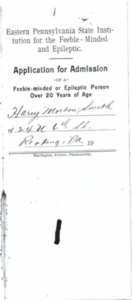2019 Scholar in Residence
The Life Stories of People Who Called Pennhurst Home: An interview with 2019 Scholar in Residence, Mary Schreiner, Ph.D.
By Jacob R. Wolff on April 1, 2020
We continue our series of interviews with former Scholars in Residence through the Pennsylvania State Archives and Pennsylvania Historical Association. In this post, we speak to Mary Schreiner, Ph.D., whose project reclaims the historical narrative for residents of the former Pennshurst State School and Hospital. Oral history videos of consenting Pennhurst survivors are also available through the Pennhurst Memorial & Preservation Alliance. Schreiner, an associate professor of education at Alvernia University, spoke with Jacob Wolff, web and social media editor for the Pennsylvania Historical Association.
JACOB WOLFF: You began your SIRs presentation by asking the audience to envision “home.” We don’t often think of former hospitals like Pennhurst as particularly inviting. They’re remembered as settings for horror films or ghost stories. But you visited the cemetery and recognized a different story — a story of respect and dignity. You also note that residents who are still living want their truths told. Tell us a little about the people who called Pennhurst home.

MARY SCHREINER: The people who called Pennhurst “home” during the twentieth century would in many cases be indistinguishable from individuals with disabilities today, other than the environment in which they lived. They came from families rich and poor in the eastern side of the state, often because in these years there were no schools, day cares, or employment situations for them in their home towns. Families were told that their sons and daughters would be better cared for at places like Pennhurst than they could be at their birthplace homes. Once at Pennhurst, life at Pennhurst could not have been more different than the homes where most of us live now.
Sleeping areas housed up to 50 others were often restless at night and noisy.
Illness and injury were often overlooked and worsened from inattention. Clothing was ill-fitting and shabby. Recreation was limited to one day a week, and for those too disabled to move themselves or shackled in cribs, recreation was non-existent. Residents attended worship on the Pennhurst grounds regardless of one’s family faith tradition and only if they demonstrated acceptable behavior and “earned” it. Dining halls were crowded and food was bland as is evident in this photo taken in 1915:

Nevertheless, some residents were capable enough to be employed at the institution as “working boys” and “working girls” for little or no pay, doing the work of keeping their “home” running….massive amounts of laundry, cooking, farming, furnace work, and even caring for their more disabled fellow residents, were done as part of these individuals’ daily routines. For those less capable, days offered little activity, often resulting in behavioral aggression and self-abuse, which in turn resulted in punishing seclusion for days in locked rooms. As a “home,” Pennhurst could hardly be called “homey” by anyone’s standards, but distance, poverty and off-putting professional advice at the time kept families from visiting or even being aware of the type of home to which they and the courts had committed their loved ones.
JW: I was struck by your methodological complexity. You first interviewed living residents, and then dug into the State Archives — through the Scholar in Residence program — to uncover much earlier histories. However, the collection of patient records is incomplete. Many files are simply lost. How did you piece together stories, like that of Harry Morton Smith, patient #1?
MS: Writing the life stories of individuals whom society has worked hard to hide was a challenging endeavor. To build one of the life stories, one needs to first have a concept of what public records exist such as the US census data and death certificates readily available online, what exists at the Archives as state institutional records such as daily rosters, admission and discharge records, event programs etc., some historical context specific to the Pennhurst locale and other state hospitals, and the state and national history of the period when the person lived.

For me, it was important that every story begin with a name. I was determined to include real names in my project because I believe the individuals who lived at Pennhurst are historical figures who shaped the disability rights movement at the latter part of last century. For me, the first actual names I saw were at a small cemetery near the Pennhurst grounds. These grave sites were indexed with death certificates by a previous researcher kind enough to post them. Through the assistance of state archivist Tyler Stump, I was privileged to see some of the over 7000 patient files retrieved and now stored in Harrisburg, representing the over 10,000 who lived at Pennhurst while it was open.
The stories then emerged after pulling bits from all of these sources. Admission documents tell about a family’s reasons for taking their son or daughter to Pennhurst. Further information in the records include diagnosis, medical and behavioral notes that inform what the likely daily lived experiences were. How I came to build the story of Harry Morton Smith is part of the presentation I made at the Archives in August.
JW: Similarly, many records were redacted to protect the rights of former patients and you couldn’t write about patients who were recently deceased. What should historians understand about consent and medical ethics when using collections like this?
MS: Doing historical research on individuals from a protected class, such as persons with intellectual disabilities who lived at state hospitals, is not as impossible as some might think, but it does take persistence!
For individuals who are deceased, the issue is more access than consent. The ethics of using the information found in such records relies upon a researcher’s respect for reporting factual information without judgment or exploitation. Use of the information to build scenarios for haunted asylums and horror films is not only offensive to the memory to all those who involuntarily lived or worked in these properties, it unfairly adds to the culture of fear and stigmatization of a vulnerable group of our fellow human beings.

In the case of researchers looking for files of those deceased less than 50 years ago, HIPAA Privacy Law prevents public access unless one can prove executor status, and it is unlikely any Pennhurst resident completed a Will. That leaves files of those who died prior to 1970, and this group will fall into two categories, according to current Pennsylvania Archive access rules.
For those deceased prior to 1970 but whose patient record includes information more recent than 75 years, unredacted access (i.e. access to personally identifying information) is not possible without a legitimate research proposal. Unfortunately, those who fit this category and lived at Pennhurst between 1945 and died by 1970 experienced the worst of the conditions there and most deserve to have their stories told. As a Scholar in Residence, I was privileged to have unredacted access, but as I write stories from this period, I (and future researchers of people living within this time span) will need to change names and other identifying information as life stories are published.
For those deceased prior to 1970 and with records older than 75 years, access to patient files is not limited and actual names can be included in what is written for the interested historian and member of the public. In this group of individuals, the supporting documents available provided a wealth of resources one can use to assemble life stories which are based on historical fact as well as personal detail.
Family historians looking for a particular person have to at least have a sense of when their family member arrived at Pennhurst. They can ask the archivists to see if their loved one’s file is among the 36 cartons of Pennhurst patient files now preserved at the State Archive location, as these cartons are organized by the number given a person on admission.
JW: This project seems to reclaim the historical narrative for residents. It also unravels the various ways medical professionals have understood, or classified, mental health over the past century. Could you speak to the importance of medical history in advancing the future of disability rights?
MS: Allow me to share a statement produced by the co-president of the Pennhurst Memorial and Preservation Alliance, James Conroy, Ph.D., which addresses this question better than I could. Dr. Conroy would be more than happy for you to quote any part of this statement from what he wrote to me in an email 8/7/2018:
The balance between letting people know about the lives and stories of people who were placed under the care of our state, against the possibility that some harm might come to them or their families, is an important risk-benefit analysis.
The Holocaust Centers considered these issues with deep respect and caring for half a century. Their final stance is well known and crystal clear. The people affected did no wrong, and their lives and identities do not place them at any risk of prosecution or infamy. Similarly, intellectual disability is not a stigma that must be hidden, protected, or kept secret. To have that standard applied to the 10,400 innocent victims of our flawed institutional system, rooted in eugenics just as the Holocaust was, would be misguided to say the least.
…. “mental health” (and by its inference, mental illness) is NOT considered synonymous with what used to be called “mental retardation,” or what at the time Pennhurst was founded, was called “feebleminded” or “epileptic.” The Eastern Pennsylvania State Institution for the Feeble-Minded and Epileptic” (i.e. Pennhurst) was established to serve the latter, whereas places like the Trans-Allegheny Lunatic Asylum and State Lunatic Hospital at Norristown served the former.
The difference in today’s world is that sadly, individuals with mental illness continue to suffer public stigma and family impacts, but by and large those with intellectual disability and epilepsy have proudly acknowledged their status in society as healthy (mentally and physically), contributing (through work and self-advocacy), community members. This status was hard-fought in courts and neighborhoods by family members of loved ones they see as historical figures in the civil rights movement in America. For these reasons, we wish to research and publish their stories, honoring them by name.
JW: You specialized in special education through your doctoral study at Penn State. As an applied discipline, public service is invaluable and that is evident in your scholarship. Will the stories you collect be involved in a larger commemoration of patients who called Pennhurst their home?
MS: I collected stories from consenting Pennhurst survivors now living in the Philadelphia area as video recordings available for public review on the Pennhurst Memorial and Preservation website. These individuals were eager to share their stories and willing allow for their names and faces to be public.
According to the organization’s website, “The Vision of the Pennhurst Memorial and Preservation Alliance is to be part of an effort to create a world-class museum to honor and memorialize the ongoing civil and human rights struggle of Americans with disabilities at a location of national significance, to assure that we never go back.” It is working now with a coalition of other organizations committed to a national commemoration effort.
When I finish writing the Pennhurst life stories that I collected through the Archives, I hope to produce a separate website and/or an audiobook tentatively entitled “Pennhurst Profiles” which will hopefully add to the commemoration of those who called Pennhurst their home between its opening in 1908 and 1960.
Finally, there is some effort noted in the East Vincent Township strategic plan to incorporate the small cemetery where 40 early Pennhurst residents are buried into a larger park development project at some point in the future.
JW: On February 20, Pittsburgh’s WTAE reported that “nearly 13,000 Pennsylvanians with intellectual disabilities are on a state waiting list for services.” I wonder if you have any thoughts on the pending closure of Polk and White Haven centers in Western Pennsylvania?
MS: My thoughts on the closure of Polk and White Haven Centers align with my deep belief that ALL persons have the right to live, be educated, work, recreate, and worship in a community setting, with access to whatever supports they might need to have a quality of life. Individuals with complex support needs, especially the elderly among those about to exit these centers, will need welcoming neighborhoods and local service providers who recognize and respect these fundamental human rights.